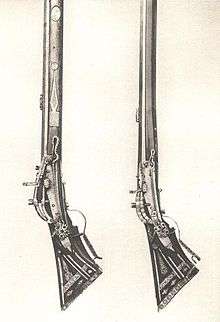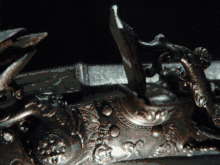Snaphance
A snaphance or snaphaunce is a type of lock for firing a gun or is a gun using that mechanism.[1] The name is Dutch in origin but the mechanism cannot be attributed to the Netherlands with certainty. It is the mechanical progression of the wheellock firing mechanism, and along with the miquelet lock and doglock are predecessors of the flintlock mechanism. It fires from a flint struck against a striker plate above a steel pan to ignite the priming powder which fires the gun.[2] Examples of this firearm can be found through Europe, North Africa, and the Middle East.

Design

Like the earlier snaplock and later flintlock, the snaphance drives flint onto steel to create a shower of sparks to ignite the priming powder in the pan, the flash partly passing through the touch hole into the barrel where it ignites the main charge (propellant).
The flint is held in a clamp at the end of a bent lever called the cock. Upon pulling the trigger, this moves forward under the pressure of a strong spring and strikes a curved plate of hardened steel (called simply the steel, or in 17th century English dialect the frizzen) to produce a shower of sparks (actually white-hot steel shavings). These fall into a flash pan holding priming powder. The flash from the pan travels through the touch hole to cause the main charge of gunpowder to explode. The steel is at the end of an arm that can be moved independently of the pan cover.
The snaphance first appeared in the late 1550s as an improvement of the earlier snaplock in one or more of the following countries: Spain, Holland, Germany, Scotland, or Sweden.[3] The main improvement was that the pan-cover opened automatically (to keep the priming dry until the exact moment of firing), as in the wheel-lock. (The snaplock had a manually operated pan cover similar to that of the matchlock. Some definitions class the snaphaunce as a sub-type of snaplock.) Also like the wheel-lock, the snaphance used a lateral sear mechanism to connect trigger to cock. Later models had a variety of safety mechanisms to prevent accidental discharge of the gun. Without these the weapons, like any firearm, could be highly dangerous: Hakluyt's "Voyages" records the death of one of the men on Cavendish's circumnavigation in the 1580s due to an accidental discharge during a hurried re-embarkation on the coast of Ecuador, specifically mentioning the weapon was a snaphance. The snaphaunce has a form of safety built into its design, since the steel (frizzen) could be manually moved forward so that if the cock should be released accidentally it would not strike sparks. This led to an inherent disadvantage: in the flintlock when at half-cock and the frizzen is closed, the flint is in close proximity to the steel and can easily be adjusted to strike square to and in the center of the steel; in the snaphaunce the cock can only be at full-cock or down, where it prevents the steel from being brought back to the firing position, so the flint is more difficult to align. The development of the snaphance occurred separately but at the same time as the creation of the miquelet.[3]
Use
The snaphance was used from the late 1550s, but by about 1680 it was gradually superseded and was still occasionally issued to reinforcements for Portugal for the British Army in the Wars of the Spanish Succession of 1703 and in Northern Italy where it was still in use until the 1750s. In Europe, and especially France, the snaphance was replaced by the flintlock with its combined steel/pan cover starting from about 1620. In England, a hybrid mechanism called the English Lock replaced the snaphance from the same date. Both the flintlock and the English lock were cheaper and less complex than the snaphance.
The snaphance dominated the New England gun market until it fell out of favor in the middle of the 17th Century. Virginia, Massachusetts, and Connecticut outlawed the outdated mechanism by the late 17th Century.[4]
Name
The origin of the name snaphance is thought to come from the Dutch "Snaphaan" which roughly means "pecking rooster" and relates to the shape of the mechanism and its downward-darting action (and would also explain the name "cock" for the beak-shaped mechanism which holds the flint). In German, the calque Schnapphahn moved away from the earlier definitions and has traditionally referred to a mounted highwayman, who would have been likely to use a firearm of that nature. The French chenapan also changed its meaning in the seventeenth century to define a rogue or scoundrel. During the Second Northern and Scanian Wars, a "Snapphane" was a pro-Danish Guerilla-man in Scania, which had just been annexed by Sweden, as they wanted to belong to Denmark instead.
In Swedish the word Snapphane is first recorded 1558 in a letter from King Gustav I to his son Duke John of Finland "reffvelske snaphaner" (Snapphanar from Tallinn-Reval), earlier correspondence were discussing Estonian privateers and problems created by them in Russian commerce. In the inventories of the Royal Armoury in Stockholm the term snapphanelås (snaphance lock) appears first in 1730, after the conquest of the former Danish provinces of Skåne, Halland and Blekinge in the 1670s. The local peasant warriors were then called snapphanar and their typical smallbore rifles (see picture) were described as having snapphanelås: locks or rifles used by the Snapphanar. In the earlier inventories the term used is always snapplås (snaplock).
See also
- Caplock mechanism
- Flintlock
- Hand cannon
- Matchlock
- Miquelet
- Percussion cap
- Snaplock
- Wheellock
- Doglock
References
- Frederick C. Mish (ed.). Merriam-Webster Dictionary (Electronic). Merriam-Webster, Incorporated. Retrieved 26 November 2012.
- Godwin, Brian. "Brian Godwin on The English Snaphance". Archived from the original on 12 August 2013. Retrieved 26 November 2012.
- Chapel, Charles Edward (2002). Guns of the Old West : an illustrated guide. Mineola, N.Y.: Dover Publications. p. 12. ISBN 9780486421612. Retrieved 26 November 2012.
Snaphance.
- Russell, Carl P. (2005). "Arming the American Indian". Guns on the early frontiers : from colonial times to the years of the Western fur trade. New York: Dover. p. 9. ISBN 978-0486436814.
Brian Godwin, The English Snaphance Lock, London Park Lane Arms Fair catalog, Spring 2006, and Classic Arms and Militaria Magazine, volume XVI Issue 1, page 48



